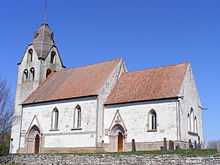Grötlingbo Church

Grötlingbo Church (Swedish: Grötlingbo kyrka) is a medieval Lutheran church on the island of Gotland, in the Diocese of Visby (Sweden).
History

The earliest written record of the church is from 1296, when it is mentioned in a papal bull.[1] Archaeological excavations carried out in 1956–1957 however show that there was a stone church here already in the 12th century.[2] The finely carved reliefs that adorn the southern façade of the present church obviously come from this first, Romanesque church and have been incorporated in the later Gothic church that is visible today. The western tower was added in the 13th century, and a major reconstruction of the church into its present form was carried out during the late 14th century. The church has remained largely unaltered since, except for a few new furnishings.[1][3]
Architecture
The church is rather large for a country church on Gotland, and built of local sandstone.[3] The nave is divided in three sections by sturdy columns. The choir lacks an apse and instead ends with three slender Gothic windows, a treatment typical for medieval churches on Gotland. The tower is Romanesque but the spire dates from the 18th century.[1]
The southern church façade is adorned with Romanesque friezes, made by the artist commonly referred to as Master Sigraf and dating from circa 1200. They depict animals, both real and mystical, as well as fighting men and knights on horseback. Scholars are divided as to what they may depict. Some speculate that they may be an illustration of evil forces, pursuing humans. Others argue that they may be illustrating an ancient tale, perhaps that of Beowulf.[1][4]
Later and Gothic in style are the two carved portals on south side of the church. They date from the middle of the 14th century and the workshop has been identified as that of Master Egypticus. They depicts Christian scenes such as the Virgin Mary and the Resurrection. Typically for Master Egypticus the sculpted portals also include grinning, grotesque faces.[1][3]
Of the interior, a few 14th century frescos survive in the choir, depicting Christian scenes of the same type as the sculpted portals.[1] The vaults in the nave also have some purely decorative paintings.[2] Between the nave and the choir hangs a large triumphal cross, dating from the middle of the 1200s. The baptismal font is particularly noteworthy, also a work done by Master Sigraf and one of the finest examples of the sculptor's art.[5] The pulpit dates from the Renaissance and was originally made for Visby Cathedral. It still displays the Danish coat of arms, rather than the Swedish.[1][3]
Gallery with the external Romanesque frieze
-

Detail of the frieze on the south façade
-

Detail of the frieze on the south façade
-

Detail of the frieze on the south façade
-

Detail of the frieze on the south façade
-

Detail of the frieze on the south façade
References
- ↑ 1.0 1.1 1.2 1.3 1.4 1.5 1.6 Svahnström, Gunnar (1973). Lagerlöf, Erland, ed. Gotlands kyrkor (in Swedish). Uddevalla: Rabén & Sjögren. pp. 153–156. ISBN 9129410355.
- ↑ 2.0 2.1 Andrén, Anders (2011). Det Medeltida Gotland. En arkeologisk guidebok (in Swedish). Lund: Historiska Media. pp. 206–210. ISBN 978-91-85873-83-8.
- ↑ 3.0 3.1 3.2 3.3 Jonsson, Marita; Lindquist, Sven-Olof (1987). Vägen till kulturen på Gotland (in Swedish). Visby: Gotlands fornsal. pp. 188–189. ISBN 91-971048-1-7.
- ↑ Enderborg, Bernt. "Grötlingbo kyrka, Gotland". guteinfo.com (in Swedish). Retrieved July 23, 2013.
- ↑ Svanberg, Jan (1995). Karlsson, Lennart, ed. Signums svenska konsthistoria: Den romanska konsten (in Swedish). Lund: Signum. p. 207. ISBN 91-87896-23-0.
External links
 Media related to Grötlingbo church at Wikimedia Commons
Media related to Grötlingbo church at Wikimedia Commons
Coordinates: 57°08′01″N 18°20′47″E / 57.13361°N 18.34639°E